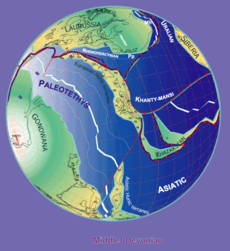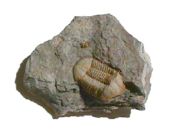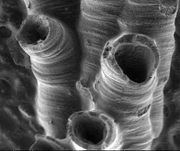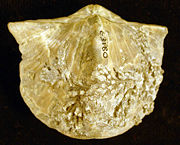Devonian
2008/9 Schools Wikipedia Selection. Related subjects: Geology and geophysics
| Devonian period 416 - 359.2 million years ago |
|
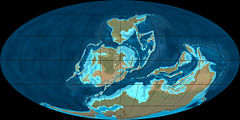 |
|
| Mean atmospheric O2 content over period duration | ca. 15 Vol % (75 % of modern level) |
| Mean atmospheric CO2 content over period duration | ca. 2200 ppm (8 times pre-industrial level) |
| Mean surface temperature over period duration | ca. 20 °C (6 °C above modern level) |
|
Events of the Devonian period
view • discuss •
-420 —
–
-415 —
–
-410 —
–
-405 —
–
-400 —
–
-395 —
–
-390 —
–
-385 —
–
-380 —
–
-375 —
–
-370 —
–
-365 —
–
-360 —
–
-355 —
←
Rhynie chert
←
Hangenberg event
←
Kellwasser event(s)
←
Widespread
shrubs & trees ←
S. America
glaciation begins ←
Hunsrück fauna
e v o n i a n Palæozoic
Key events of the Devonian period.
Axis scale: millions of years ago. |
|
The Devonian is a geologic period and system of the Paleozoic era spanning from to million years ago ( ICS, 2004). It is named after Devon, England, where rocks from this period were first studied.
During the Devonian Period, which occurred in the Paleozoic era, the first fish evolved legsand started to walk on land as tetrapods around 365 Ma. Various terrestrial arthropods also became well-established.
The first seed-bearing plants spread across dry land, forming huge forests. In the oceans, primitive sharks became more numerous than in the Silurian and the late Ordovician, and the first lobe-finned and bony fish. The first ammonite mollusks appeared, and trilobites, the mollusc-like brachiopods, as well as great coral reefs were still common. The Late Devonian extinction severely affected marine life.
The paleogeography was dominated by the supercontinent of Gondwana to the south, the continent of Siberia to the north, and the early formation of the small supercontinent of Euramerica in the middle.
Naming
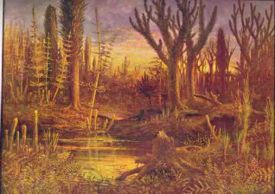
The period is named after Devon, a county in southwestern England, where Devonian outcrops are common. While the rock beds that define the start and end of the period are well identified, the exact dates are uncertain. According to the International Commission on Stratigraphy (Ogg, 2004), the Devonian extends from the end of the Silurian Period 416.0 ± 2.8 million years ago (Mya), to the beginning of the Carboniferous Period 359.2 ± 2.5 Mya (in North America, the beginning of the Mississippian subperiod of the Carboniferous) (ICS 2004).
Well into the 20th century, the Devonian was often quoted as being "the age of fishes", referring to the great diversification of various piscine groups in the period. While the development of fishes is of great importance from an anthropocentric point of view (inasmuch as they are our vertebrate relatives), the name is now avoided, as fishes were but one of several important groups to see extensive development on the Devonian (see under Devonian biota). The name is frequently found in older (and a few newer) works.
In nineteenth-century texts the Devonian has been called the "Old Red Age", after the red and brown terrestrial deposits known in the United Kingdom as the Old Red Sandstone in which early fossil discoveries were found.
The Devonian has also erroneously been characterized as a "greenhouse age", due to sampling bias: most of the early Devonian-age discoveries came from the strata of western Europe and eastern North America, which at the time straddled the Equator as part of the supercontinent of Euramerica where fossil signatures of widespread reefs indicate tropical climates that were warm and moderately humid but in fact the climate in the Devonian differed greatly between epochs and geographic regions. For example, during the Early Devonian, arid conditions were prevalent through much of the world including Siberia, Australia, North America, and China, but Africa and South America had a warm temperate climate. In the Late Devonian, by contrast, arid conditions were less prevalent across the world and temperate climates were more common.
Devonian subdivisions
The Devonian Period is formally broken into Early, Middle, and Late subdivisions. The rocks corresponding to these epochs are referred to as belonging to the Lower, Middle, and Upper parts of the Devonian System. The international standard faunal stages from youngest to oldest are:
Late (most recent)
Middle
Early (oldest)
Devonian palaeogeography
The Devonian period was a time of great tectonic activity, as Laurasia and Gondwanaland drew closer together.
The continent Euramerica (or Laurussia) was created in the early Devonian by the collision of Laurentia and Baltica, which rotated into the natural dry zone along the Tropic of Capricorn, which is formed as much in Paleozoic times as nowadays by the convergence of two great airmasses, the Hadley cell and the Ferrel cell. In these near-deserts, the Old Red Sandstone sedimentary beds formed, made red by the oxidized iron ( hematite) characteristic of drought conditions.
Near the equator, Pangaea began to consolidate from the plates containing North America and Europe, further raising the northern Appalachian Mountains and forming the Caledonian Mountains in Great Britain and Scandinavia.
The west coast of Devonian North America, by contrast, was a passive margin with deep silty embayments, river deltas and estuaries, in today's Idaho and Nevada; an approaching volcanic island arc reached the steep slope of the continental shelf in Late Devonian times and began to uplift deep water deposits, a collision that was the prelude to the mountain-building episode of Mississippian times called the Antler orogeny.
The southern continents remained tied together in the supercontinent of Gondwana. The remainder of modern Eurasia lay in the Northern Hemisphere. Sea levels were high worldwide, and much of the land lay submerged under shallow seas, where tropical reef organisms lived.
The deep, enormous Panthalassa (the "universal ocean") covered the rest of the planet. Other minor oceans were Paleo-Tethys, Proto-Tethys, Rheic Ocean, and Ural Ocean (which was closed during the collision with Siberia and Baltica).
Devonian rocks are oil and gas producers in some areas.
Devonian biota
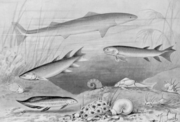
Marine biota
Sea levels in the Devonian were generally high. Marine faunas continued to be dominated by bryozoa, diverse and abundant brachiopods, the enigmatic hederelloids, and corals. Lily-like crinoids were abundant, and trilobites were still fairly common, but less diverse than in earlier periods due to the abundance of mobile swimming predators such as early sharks and predatory bony fish (Osteichthyes) such as Dunkleosteus. The ostracoderms were joined in the mid-Devonian by the first jawed fishes and were declining in diversity and were being out competed by the jawed fish in both the sea and fresh water, also the great armored placoderms, as well as the first sharks and ray-finned fish. The first abundant species of shark, the Cladoselache, appeared in the oceans during the Devonian period. They became abundant and diverse. In the late Devonian the lobe-finned fish appeared, giving rise to the first tetrapods.
The first Ammonites also appeared during or slightly before the early Devonian period around 400 million years ago.
A recently discovered fossil of a fish embryo attached to its mother by an umbilical cord in 380 million year old Devonian strata provides the earliest fossil evidence of vertebrates giving live birth to their young.
Reefs
A great barrier reef, now left high and dry in the Kimberley Basin of northwest Australia, once extended a thousand kilometers, fringing a Devonian continent. Reefs in general are built by various carbonate-secreting organisms that have the ability to erect wave-resistant frameworks close to sea level. The main contributors of the Devonian reefs were unlike modern reefs, which are constructed mainly by corals and calcareous algae. They were composed of calcareous algae and coral-like stromatoporoids, and tabulate and rugose corals, in that order of importance.
Terrestrial biota
By the Devonian Period, life was well underway in its colonization of the land. The moss forests and bacterial and algal mats of the Silurian were joined early in the period by primitive rooted plants that created the first stable soils and harbored arthropods like mites, scorpions and myriapods (although arthropods appeared on land much earlier than in the Early Devonian and the existence of fossils such as Climactichnites suggest that land arthropods may have appeared as early as the Cambrian period). Early Devonian plants did not have roots or leaves like the plants most common today, and many had no vascular tissue at all. They probably spread largely by vegetative growth, and did not grow much more than a few centimeters tall. Also the first possible fossils of insects appeared around 416 Ma in the Early Devonian.
By the Devonian, shrub-like forests of small, primitive plants existed: lycophytes, sphenophytes, ferns, and progymnosperms had evolved. Most of these plants had true roots and leaves, and many were quite tall. In the Late Devonian, the tree-like ancestral fern Archaeopteris and the giant cladoxylopsid trees grew with true wood. (See also: lignin.) These are the oldest known trees of the world's first forests. Prototaxites was the fruiting body of an enormous fungus that stood more than 8 meter tall. By the end of the Devonian, the first seed-forming plants had appeared. This rapid appearance of so many plant groups and growth forms has been called the "Devonian Explosion". Primitive arthropods co-evolved with this diversified terrestrial vegetation structure. The evolving co-dependence of insects and seed-plants that characterizes a recognizably modern world had its genesis in the Late Devonian. The development of soils and plant root systems probably led to changes in the speed and pattern of erosion and sediment deposition. The rapid evolution of a terrestrial ecosystem containing copious animals opened the way for the first vertebrates to seek out a terrestrial living. By the end of the Devonian, early amphibians and arthropods were solidly established on the land.
The earliest known trees, from the genus Wattieza, appeared in the Late Devonian around 380 Ma.
The 'greening' of the continents acted as a carbon dioxide sink, and atmospheric levels of this greenhouse gas may have dropped. This may have cooled the climate and led to a massive extinction event. See Late Devonian extinction.
Late Devonian extinction
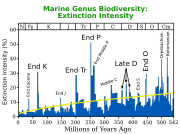
A major extinction occurred at the beginning of the last phase of the Devonian period, the Famennian faunal stage, (the Frasnian-Famennian boundary), about 364 million years ago, when all the fossil agnathan fishes, save for the psammosteid heterostracans, suddenly disappeared. A second strong pulse closed the Devonian period. The Late Devonian extinction was one of five major extinction events in the history of the Earth's biota, more drastic than the familiar extinction event that closed the Cretaceous.
The Devonian extinction crisis primarily affected the marine community, and selectively affected shallow warm-water organisms rather than cool-water organisms. The most important group to be affected by this extinction event were the reef-builders of the great Devonian reef-systems .
Amongst the severely affected marine groups were the brachiopods, trilobites, ammonites, conodonts, and acritarchs, as well as jawless fish, and all placoderms. Land plants as well as freshwater species, such as our tetrapod ancestors, were relatively unaffected by the Late Devonian extinction event.
Reasons for the late Devonian extinctions are still speculative. The Canadian paleontologist Digby McLaren suggested in 1969 that the Devonian extinction events were caused by an asteroid impact; however, little evidence supports the existence of a Devonian crater large enough.
